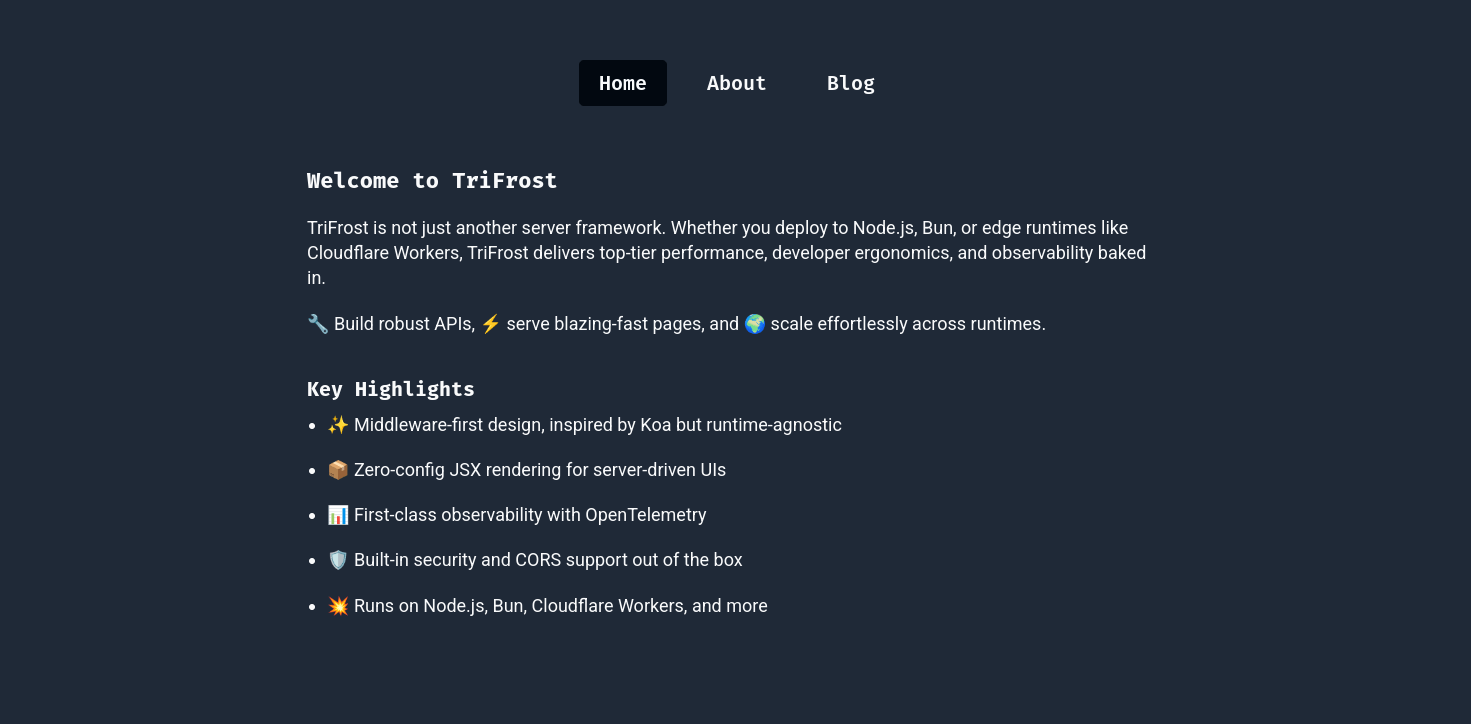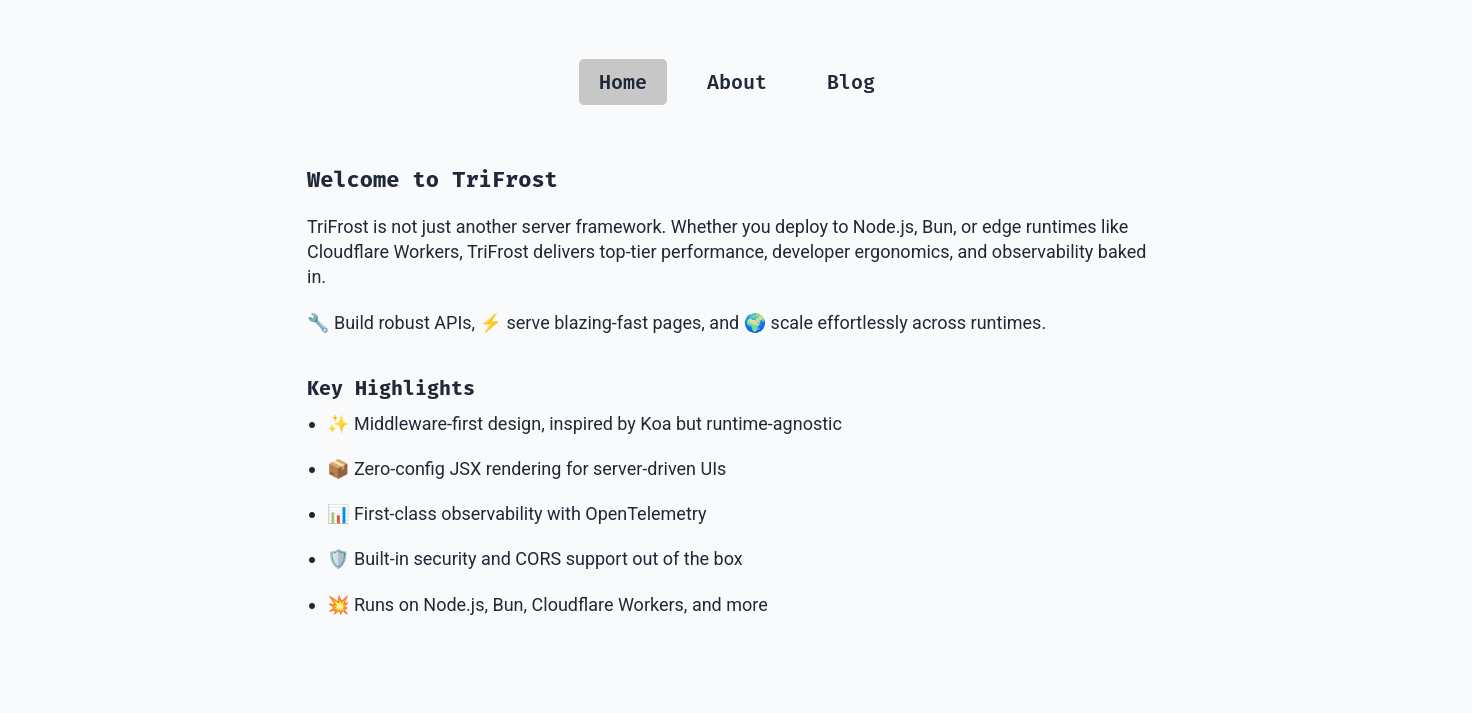Mini Site (Node + Podman)
This example showcases a multi-page server-rendered TriFrost application running on Node.js, containerized with Podman.
It demonstrates runtime-agnostic rendering, HTMX-driven interactivity (for comments), and optional observability with SigNoz.
How It Works
The app uses TriFrost’s flexible routing and JSX rendering to deliver a home page, about page, and a blog page with dynamic comments.
HTMX handles comment posting and deletion via fragment swaps, making it lightweight and responsive without a heavy frontend framework.
You can run it standalone with Node.js or containerize it with Podman and Podman Compose — a perfect showcase of TriFrost’s runtime flexibility (just compare it with our Cloudflare Example and you'll note there's very little that needs to change).
This example is set up to optionally send OpenTelemetry traces to SigNoz, giving you visibility into route performance, request flows, and system health.
To enable it, provide your SIGNOZ_API_TOKEN in a .env file and uncomment the OtelHttpExporter block in index.ts and you're good to go.
Project Structure
trifrost-mini-site/
├─ src/
│ ├─ components/
│ ├─ pages/
│ ├─ css.ts
│ ├─ index.ts
│ └─ types.ts
├─ Containerfile
├─ compose.yml
├─ package.json
├─ tsconfig.json
└─ .envLogic
The app is initialized in index.ts using TriFrost’s App class. Middleware like security and CORS are added, then routing groups (homeRouter, aboutRouter, blogRouter) are wired in.
Each page uses server-rendered JSX, the blog section includes dynamic comment handling through HTMX.
The client option with our css instance ensures TriFrost Atomic (0.36+) automounts our css root to /__atomics__/client.css, ensuring no repeat global styles but only page-specific styles get inlined.
// src/index.ts
import {App, Security, Cors, OtelHttpExporter} from '@trifrost/core';
import {type Env} from './types';
import {homeRouter} from './pages/home';
import {aboutRouter} from './pages/about';
import {blogRouter} from './pages/blog';
import {notFoundHandler} from './pages/notfound';
import {css} from './css';
new App<Env>({client: {css}})
.use(Security())
.use(Cors())
.group('/', homeRouter)
.group('/about', aboutRouter)
.group('/blog', blogRouter)
.onNotFound(notFoundHandler)
.boot({port: Number(process.env.PORT || 3000)});Page Breakdown
Each of these pages is set up as its own router group (homeRouter, aboutRouter, blogRouter) and connected in the main index.ts.
They use a shared layout wrapper for consistency, pulling in navigation, headers, and theme-aware styles.
- Home Page (
/)
Provides a welcoming introduction to TriFrost, explaining its mission as a runtime-agnostic, fast server framework. Uses a simple JSX layout with hero text and buttons. - About Page (
/about)
Gives background on what makes TriFrost special, its composable middleware, multi-runtime compatibility (Node, Bun, Workerd), and built-in observability. This page uses bullet lists and styled sections. - Blog Page (
/blog)
The most interactive section, listing blog posts and allowing users to submit and delete comments live via HTMX. This showcases TriFrost’s ability to handle fragment rendering and dynamic state updates without a heavy frontend framework.
Styling
Styling is centralized in css.ts using TriFrost’s createCss system. It defines dark/light themes, font families, spacing scales, and responsive helpers, enabling consistent component styling and easy overrides.
Once a var/theme variable is defined they are respectively available at css.$v.[variable name] and css.$t.[variable name] anywhere in your app.
Important Notes:
- definitions are not included in the css if not used. They form your backbone to centralize reusable pieces of styling without bloating the page if not used, they get merged in with client styles by using
css.useandcss.mix. - Since TriFrost 0.36 Atomic, global styles such as the css reset and theme/global variables get bundled in a file and mounted at
__atomics__/client.cssif you pass yourcssinstance as part of the client options on App. The system takes care of adding the link automatically to your output HTML.
// src/css.ts
export const css = createCss({
reset: true,
var: {
font_header: "'Fira Code', monospace",
font_body: "'Roboto', Sans-serif",
radius: '0.5rem',
space_s: '0.5rem',
space_m: '1rem',
space_l: '2rem',
space_xl: '4rem',
},
theme: {
bg: {
light: '#f9fafb',
dark: '#1f2937',
},
fg: {
light: '#1f2937',
dark: '#f9fafb',
},
nav_bg: {
dark: '#020810',
light: '#c7c7c7',
},
nav_fg: {
dark: '#ffffff',
light: '#000000',
},
...
},
definitions: (mod) => ({
f: () => ({display: 'flex'}),
fh: () => ({flexDirection: 'row'}),
fv: () => ({flexDirection: 'column'}),
fa_c: () => ({alignItems: 'center'}),
fj_c: () => ({justifyContent: 'center'}),
sm_v_l: () => ({marginBottom: mod.$v.space_l, marginTop: mod.$v.space_l}),
text_header: () => ({
fontFamily: mod.$v.font_header,
fontWeight: 'bold',
[mod.media.desktop]: {
fontSize: '2.2rem',
},
[mod.media.tablet]: {
fontSize: '2rem',
},
}),
text_title: () => ({
fontFamily: mod.$v.font_header,
fontWeight: 'bold',
fontSize: '2rem',
}),
...
}),
});PS: If you want to check out the different light/dark modes, open up dev tools in Chrome (assumption, sorry ^^):
// In the Chrome DevTools Console:
document.documentElement.setAttribute('data-theme', 'dark'); // Switch to dark mode
document.documentElement.setAttribute('data-theme', 'light'); // Switch to light modeContainerization
The Containerfile uses a multi-stage build: first compiling the TypeScript project, then packaging only production files.
This is also the file that builds your source into a container ready for deployment.
# =============================================================================
# Development Stage
# =============================================================================
FROM node:22-alpine AS development
WORKDIR /app
COPY package*.json ./
RUN npm install
# Copy source
COPY . .
# Start dev server
CMD ["npm", "run", "dev"]
# =============================================================================
# Build Stage
# =============================================================================
FROM development as builder
RUN npm run build
# =============================================================================
# Production Stage
# =============================================================================
FROM node:22-alpine AS production
# Set NODE_ENV to production
ENV NODE_ENV=production
WORKDIR /app
COPY package*.json ./
COPY --from=builder /app/dist ./dist
# Install dependencies and prune
RUN npm install --omit=dev && npm prune
# Change to 1000 user
RUN chown 1000:1000 /app
# Switch user
USER 1000:1000
# Start prod server
CMD ["node", "./dist/index.js"]compose.yml defines the service, port mappings, and volume mounts for local orchestration.
version: '3'
services:
website:
build:
context: .
target: development
tty: true
environment:
- PORT=3000
- TRIFROST_NAME="TriFrost_Website"
- TRIFROST_VERSION="1.0.0"
ports:
- "3000:3000"
volumes:
- './:/app:z'
- 'node_modules:/app/node_modules:z'
volumes:
node_modules:Environment
We define an Env type in types.ts to describe environment bindings like PORT and optional observability tokens like SIGNOZ_API_TOKEN. This lets the app pull runtime config from process.env without hardcoding values, making it deployment-flexible.
We also define our own app-specific Context and Router types here. These will automatically be aware of our Environment simply by passing it as a generic.
Note: When working with Podman, you will need to also provide the Environment bindings in
compose.ymlfor local development.
// src/types.ts
import {type TriFrostRouter, type TriFrostContext} from '@trifrost/core';
export type Env = {
PORT: string;
SIGNOZ_API_TOKEN: string;
};
export type Context<State extends Record<string, unknown> = {}> = TriFrostContext<Env, State>;
export type Router<State extends Record<string, unknown> = {}> = TriFrostRouter<Env, State>;
